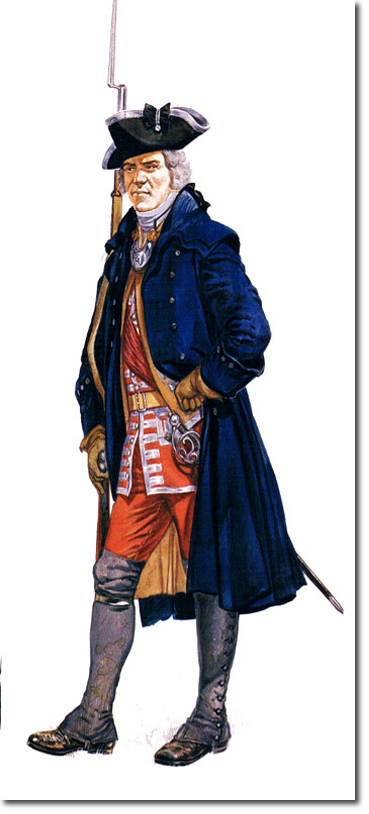|
|


|
|
The battle of Culloden was fought on a cold April day after a morning of squally showers. The officer in this illustration by Gerry Embleton is dressed in an overcoat although it is doubtful whether this would have been allowed on the field of battle. However, it is possible to see his red uniform with dull yellow facings and silver lace. The caption says that he is an officer of the grenadier company who has removed his expensive embroidered mitre cap and replaced it with a silver-laced tricorn hat. The men in his company would have had to wear their mitre caps for the battle. For some reason he has his crimson sash under his jacket. Battalion company officers normally carried espontoons or half-pikes, but grenadier officers traditionally had privately purchased fusils or light muskets, and these are depicted in the paintings of Culloden made by Morier. '
This illustration is from Like Hungry Wolves - Culloden Moor 16 April 1746 by Stuart Reid. (Windrow and Greene 1994).' The caption to this plate says, 'Although latterly they were to become the Somerset Light Infantry, Colonel Harry Pulteney's 13th Foot had in fact a long association with Scotland beginning in 1689 when, as Colonel Ferdinando Hastings' Regiment, they survived a Highland charge on the Braes o' Killiecrankie. In 1740 over a third of the officers then serving in the regiment were Scots, and this association was to continue long after the rebellion, with a prolonged period in Highland garrisons; even as late as 1761 at least one officer in six was Scottish, and the adjutant, Lt William Bannatyne, came from Inverness-shire. |
Armed Forces | Art and Culture | Articles | Biographies | Colonies | Discussion | Glossary | Home | Library | Links | Map Room | Sources and Media | Science and Technology | Search | Student Zone | Timelines | TV & Film | Wargames